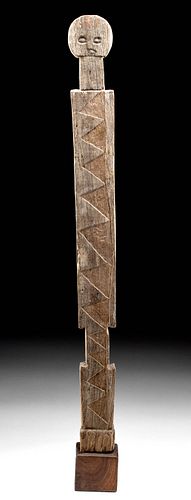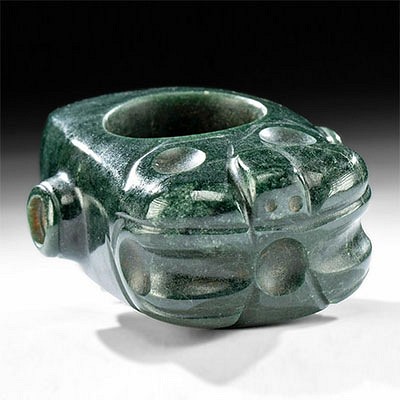Early 20th C. African Giryama Wood Kikango Sculpture
Lot 141e
About Seller
Artemis Fine Arts
686 S Taylor Ave, Ste 106
Louisville, CO 80027
United States
Selling antiquities, ancient and ethnographic art online since 1993, Artemis Gallery specializes in Classical Antiquities (Egyptian, Greek, Roman, Near Eastern), Asian, Pre-Columbian, African / Tribal / Oceanographic art. Our extensive inventory includes pottery, stone, metal, wood, glass and textil...Read more
Categories
Estimate:
$1,500 - $2,500
Absentee vs Live bid
Two ways to bid:
- Leave a max absentee bid and the platform will bid on your behalf up to your maximum bid during the live auction.
- Bid live during the auction and your bids will be submitted real-time to the auctioneer.
Bid Increments
| Price | Bid Increment |
|---|---|
| $0 | $25 |
| $300 | $50 |
| $1,000 | $100 |
| $2,000 | $250 |
| $5,000 | $500 |
| $10,000 | $1,000 |
| $20,000 | $2,500 |
| $50,000 | $5,000 |
| $100,000 | $10,000 |
| $200,000 | $20,000 |
About Auction
By Artemis Fine Arts
Sep 10, 2020
Set Reminder
2020-09-10 10:00:00
2020-09-10 10:00:00
America/New_York
Bidsquare
Bidsquare : Antiquities | Asian | Ethnographic Art
https://www.bidsquare.com/auctions/artemis-gallery/antiquities-asian-ethnographic-art-5546
Featuring classical antiquities, ancient and ethnographic art from cultures encompassing the globe. Egyptian, Greek, Roman, Etruscan, Near Eastern, Asian, Pre-Columbian, Native American, African / Tribal, Oceanic, Spanish Colonial, Russian, Fossils, Fine Art, more! Artemis Fine Arts info@artemisfinearts.com
Featuring classical antiquities, ancient and ethnographic art from cultures encompassing the globe. Egyptian, Greek, Roman, Etruscan, Near Eastern, Asian, Pre-Columbian, Native American, African / Tribal, Oceanic, Spanish Colonial, Russian, Fossils, Fine Art, more! Artemis Fine Arts info@artemisfinearts.com
- Lot Description
Eastern Africa, Kenya, Nyika peoples, Giryama (also Giriyama, Giriama) group, ca. early 20th century CE. A hand-carved hardwood funerary sculpture known as a kikango (also kikangu) that serves several functions. Likely carved from nzizi wood, this kikango presents an anthropomorphic figure with a circular head incised with a minimalist countenance, a broad neck, and a tall rectangular body with an incised sideways serration pattern adorned with faint orange pigment. The significance of this piece has multiple interpretations. First and foremost, the kikangu stands as a grave marker created to honor the Koma, or ancestor spirits, and serving as a mediator between the world of the living and the ancestral realm. Individuals worship the Koma of their immediate ancestors, and the Koma of the whole tribe is incited on special communal occurrences such as famine, war, or the sewing of crops. Size: 2.8" W x 29.25" H (7.1 cm x 74.3 cm); 32" H (81.3 cm) on included custom stand.
For a great example of a kikango post, please see The Metropolitan Museum of Art, accession number 1993.522
Another example hammered for EUR 31,250 ($35,371.56) at Christie's, Paris "Arts d'Afrique et d'Oceanie" auction (sale 15050, November 22, 2017, lot 61).
Provenance: private Orange County, California, USA collection acquired before 2000; ex-Royal-Athena Gallery, New York, New York, USA
All items legal to buy/sell under U.S. Statute covering cultural patrimony Code 2600, CHAPTER 14, and are guaranteed to be as described or your money back.
A Certificate of Authenticity will accompany all winning bids.
We ship worldwide and handle all shipping in-house for your convenience.
#156321Nicks, abrasions, and stable hairline fissures to head, neck, body, and base, and fading to original pigmentation. Smooth patina throughout and light remains of pigment across obverse. Old inventory label on back of wooden stand.Condition
- Shipping Info
-
All shipping is handled in-house for your convenience. Your invoice from Artemis Gallery will include shipping calculation instructions. If in doubt, please inquire BEFORE bidding for estimated shipping costs for individual items.
-
- Buyer's Premium



 EUR
EUR CAD
CAD AUD
AUD GBP
GBP MXN
MXN HKD
HKD CNY
CNY MYR
MYR SEK
SEK SGD
SGD CHF
CHF THB
THB















